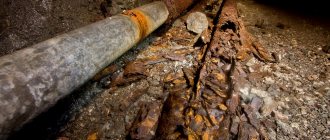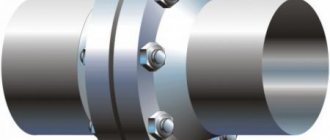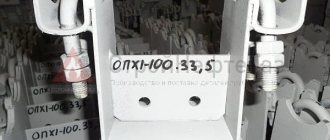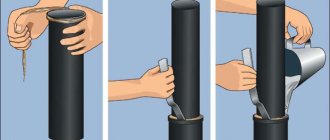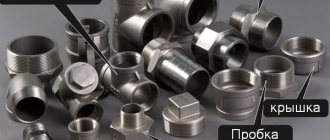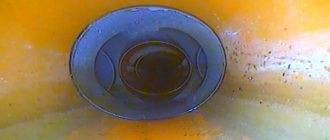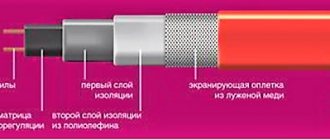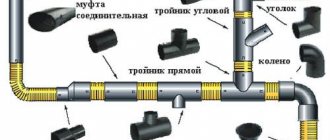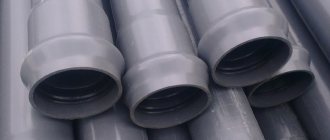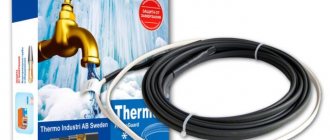PPU insulation technology
What is PPU pipe insulation? The name is intricate, but the process is simple - like all ingenious things. The design is essentially an ordinary pipe, but coated with a special layer that reduces wear of parts and reduces heat transfer losses in the network. The coating material is called polyurethane foam, hence the name of the product - polyurethane foam.
Manufacturing of structures
What methods of implementation of polyurethane foam pipe insulation do manufacturers practice? The coating is applied in two ways:
- By making a “shell”.
- By filling. This technology is also called “pipe in pipe”.
In simple terms, PPU thermal insulation for pipes is a kind of “fur coat” put on the base shell. So, what is included in such a design?
- the deepest layer is the steel base;
- middle thermal insulation layer – polyurethane foam;
- protective shell.
Everything is clear with the first two positions, but what is used as protection for products? It all depends on where and under what conditions you lay communications. If the network runs above the ground (aerial laying), then galvanized steel is chosen as protection, when installing the system in the ground involves the use of a polyethylene sheath.
This is important to know! Products covered with polyurethane foam must be protected from getting the ends wet during transportation to the installation site and storage in the open air, otherwise short circuits in the wires may occur during installation. If the insides of the elements are wet, dry everything thoroughly before use.
Advantages of PPU coating
Pipes with polyurethane foam insulation have long been popular, but for us such products are still a novelty. Get acquainted with the advantages of the design and modernize your farm.
So, the advantages of polyurethane foam-coated networks:
- increased service life (with proper installation, the life of the system can be extended several times – up to 30 years);
- reduction of heat loss during heat transfer (approximately up to 40%);
- ease of installation (you do not need complex equipment for insulating polyurethane foam pipes, since such products can be laid directly into a trench using technology - without the use of traditional concrete rings or the construction of a well);
- design features make it possible to quickly determine on which section of the water supply route the accident occurred;
- the absence of toxic materials in the composition of the product, which makes them the favorites of users who adhere to naturalness in everything;
- reducing the cost of road repairs;
- eliminating the risk of system wetting due to moisture condensation;
- high heat resistance of products, thanks to which they can be installed even in areas with harsh climates;
- the possibility of using a remote control system for the humidification of network elements.
Worth paying attention! The properties of polyurethane foam are explained by its special structure: the material is characterized by low density and a large number of closed pores.
Features and advantages of PPU insulation
There are increased demands on materials, design and installation of networks, which is due to the significant operating pressure and temperature of the coolant. And the insulation characteristics determine the level of heat loss on the route. We suggest using PPU - polyurethane foam, which has high insulating properties. Compared to traditional materials used for laying such lines, it provides the following basic advantages:
- reduction of heat loss up to 40%;
- increased service life - for polyurethane foam it is about 30 years instead of the usual 10-15;
- reduction of repair costs (3 times).
Laying out the system
How are pipes insulated with polyurethane foam installed? The most painful place in this process is sealing the joints, so it is worth talking about it in more detail.
Materials for work
In addition to pipes, the process will require the following elements:
- shut-off valves;
- supports;
- bends;
- Ball Valves;
- Z-shaped elements;
- tees;
- connection kits (tape, heat-shrink sleeve, locking casing, seal, etc.);
- galvanized pipe - in polyurethane foam insulation is used for installation of overhead routes.
Pay special attention to the quality of purchased materials for sealing joints. They must comply with GOST, otherwise there will be a risk of destruction of the system at the junction of the elements. First, rust will appear, and then leaks.
Installation
Remember the stages of installation of the system.
- Step back 30 cm from the edge of each element and strip off the insulation along this section.
- Carry out welding work. Check the strength of the connection using a special device - a flaw detector.
- Make sure the connection points are dry and clean.
- Install a heat shrink sleeve onto the structure.
- Fill the space between the coupling and the base pipe with polyurethane foam.
- While heating, press down the coupling. With this step you will achieve perfect tightness of the outer layer.
This is important to know! When connecting elements coated with polyurethane foam or polyethylene, do not forget about the flammability of these materials - during welding work, cover the ends with non-flammable material, for example, asbestos fabric.
Thanks to the use of pipes with PPU insulation, you can not only keep heat in the system and keep the nerve cells in order, but also save on installation and maintenance of the network.
Installation of polyurethane foam pipes
Instructions for installing coupling connections at the joints of pipes with PPU insulation in a PE shell (PPU-PE pipes)
Preparatory work for installation
The connecting coupling is installed on a polyurethane foam pipe in a PE shell before welding the butt joint of the steel pipes of the heating main. The packaging film should not be removed until the process of sealing the joint has begun! Be sure to check that the marking of the coupling used corresponds to the diameter of the sheath of the pipeline being insulated. The ends of steel pipes free from polyurethane foam insulation at the joint must amount to:
- no more than 300 mm for PPU-PE steel pipes with a diameter from 57 mm to 273 mm;
- no more than 500 mm for PPU-PE steel pipes with a diameter over 273 mm.
Necessary conditions for carrying out work
It is necessary to start insulating joints only after a technical examination of the welds of steel pipes. Work must be carried out at an air temperature of at least -10 C0, and also in the presence of special technological pits of at least 1.4 m (0.7 m in each direction from the joint) and 400 mm deep.
Preparatory work
Before installing the heat-shrinkable coupling, each pipe in the joint area is cleaned of rust and dirt residues. To do this, use a cord brush (for metal). If the shell or pipe is very dirty, they can be washed and dried with a gas torch. At the same time, make sure that the coupling placed on one of the working edges is covered with a protective film. The film can only be removed at the time of isolation.
Important to remember:
- the coupling is selected according to the diameter of the shell;
- if the shell interferes with welding, it is additionally removed;
- the total length of the free ends of the pipes is up to 300 mm (for lines with a diameter of 57-291 mm) or up to 450 mm (for lines with a diameter of 273 mm).
To eliminate the possibility of damage to the shell and leakage of the medium, an ODK system (operational remote control system) is installed at the preparatory stage. Before shrinking the thermal couplings, the edges of the PU foam shells of already welded pipes are cleaned and degreased. In this way, an absolutely clean surface is achieved on which the coupling will move and on which it will be seated - this is required by the instructions for insulating joints of polyurethane foam pipes.
Purpose and main advantages of products
PPU pipes are ordinary steel products for plumbing or heating, which are covered in production with a layer of polyurethane foam insulation (foamed polyurethane).
Depending on how the installation needs to be carried out (laying in the ground or installing the pipeline in the air), there are two types of external protective coating on top of the polyurethane foam insulation layer.
In order to install a pipeline in the ground, it would be ideal to choose a polyurethane foam pipe, in which the thermal insulation is protected by a polyethylene protective layer (the product is called polyethylene polyethylene). For air installation, the thermal insulation is protected by a layer of good old galvanized steel. These products in the price lists have about.
Production technology
Diagram of the structure of a polyurethane foam pipe.
There are no technical difficulties in the production of polyurethane foam pipes: a regular steel pipe is coated with polyurethane foam insulation (known to builders as ordinary polyurethane foam), after which a protective outer layer of galvanized or polyethylene is applied to the product.
The technology for producing polyurethane foam pipes in general looks like this:
Heated polyethylene is squeezed out of the reservoir through a mold, resulting in an outer shell, after which an ordinary steel pipe is placed into it. The space between the pipe and the shell is filled with foamed polymer, which quickly hardens when in contact with air.
GOST 30732-2006, which was finally adopted only in 2006, while steel pipes with pre-installed thermal insulation were already being thoroughly produced. It is curious that this standard does not regulate the manufacture of products with a protective galvanized iron layer. The text of the standard only mentions PPU-PE products.
According to the text of the existing standard, the following product diameters are allowed:
| Type No. 1 | Type No. 2 |
Outer diameter (mm)
Outer diameter of shell (mm)
Outer diameter (mm)
Outer diameter of shell (mm)
Type No. 1 - conventional thermal insulation is used, type No. 2 - reinforced thermal insulation is used.
Laying a pipeline using polyurethane foam pipes
It is worth remembering that the ends of the stripped insulation must be covered with non-flammable material during welding.
Installation of the PPU product consists of the following main stages:
- The thermal insulation is stripped to a distance of no more than 300 mm from each edge of the product;
- a welded joint is made, which must be checked for strength using a portable flaw detector;
- A heat-shrinkable sleeve is mounted on the pipe;
- the cavity under the heat-shrinkable sleeve is filled with polyurethane foam, after which the sleeve is settled in place by heating it, thereby ensuring the tightness of the outer layer of the joints.
When sealing joints, you should know that, due to the fact that polyethylene and polyurethane foam are flammable materials, the ends of the stripped insulation must be covered with any non-flammable material during welding work. To protect the outer shell, you can use, for example, asbestos fabric.
Often, installation of pipes that have pre-installed thermal insulation is carried out using horizontal drilling. In a large populated area, digging up a busy highway is very problematic. However, how to insulate a pipe if it has already been pulled through a horizontal puncture in the ground? And this is where a product with a polyethylene shell, on which thermal insulation is pre-installed, comes to the rescue.
Polyurethane foam
This material has many advantages that make it popular. PPU is a shell or insulation that has useful properties: thermal conductivity, as well as the ability not to lose its structure for a long period of time.
This polyurethane foam is created on the basis of two components Izolan-45 and Voratek CD 100.
And the refinement of the technology for processing polymer materials makes it possible to create shells for insulating products of different diameters. Installation of polyurethane foam insulation can be carried out both for a new pipeline and for the repair of an old or certain section of it.
Description of PPU pipes
PPU pipes
Such products are used quite widely for laying heating networks in above-ground and ductless environments.
For above-ground installation, pipes are made with a protective metal sheath. For channelless – with an outer protective shell of low-density polyethylene.
There can be two types of insulation: 1PPU and 2PPU. The latter are used in regions with low temperatures, the first type - in regions with a temperate climate.
About the speed of installation of thermal insulation
Pipelines with insulation
Work on installing polyurethane foam insulation is carried out quite quickly, especially when compared with other methods. Moreover, this method is easy, effective and inexpensive - an ideal option. If there is a need for this, thermal insulation can be formed using separate elements. The material is easy to cut and fit to a specific pipe.
You can also reuse the shell if its quality was not affected during the first use. All this makes PPU material an excellent method for pipe insulation. This can be confirmed by numerous videos demonstrating the process.
And, nevertheless, when installing polyurethane foam pipes, you should be extremely careful so that the quality is high, only then the efficiency will be maximum. After all, external factors will not be able to have a negative impact on the condition of the products.
